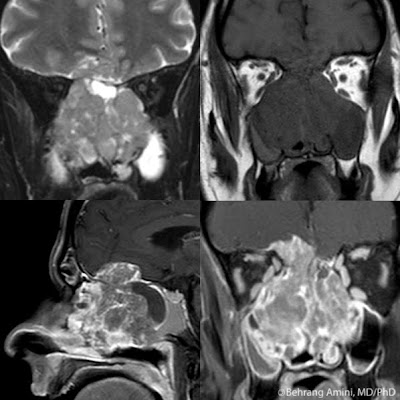
- Olfactory groove meningioma: Bone erosion in usually sclerotic, rarely destructive or scalloped. Look for a dural tail.
- Esthesioneuroblastoma (shown above): Arises in the superior nasal vault and extends through the cribriform plate. May have calcium. Cyst formation at the interface with the brain is characteristic (seen above).
- Carcinoma: Squamous cell or sinonasal undifferentiated carcinoma
- Nasal dermal sinus: Dermoid or epidermoid between tip of nose and apex of crista galli. With or without a sinus into the frontonasal region through an enlarged foramen cecum. Epidermoid will be low signal on T1, while dermoid will be high signal.
- Cephalocele: Smooth defect in the cribriform plate allows extension of brain into the nasal cavity or the sinuses.
- Bone lesions: Fibrous dysplasia, ossifying fibroma, metastases.
- Melanoma: Arises from melanocytes in sinonasal mucosa.
- Lymphoma: Low T2 signal with homogeneous enhancement.
- Sarcoidosis: Nonspecific appearance.
- Olfactory Schwannoma: Nonspecific appearance. Only interesting fact about these rare lesions is that the olfactory nerve does not contain Schwann cells, and no one knows where these Schwannomas come from (there are theories, but there is no use wasting neurons remembering speculation).
References
Amador AR, Santonja C, Del Pozo JM, Ortiz L. Olfactory schwannoma. Eur Radiol. 2002 Apr;12(4):742-4.

No comments:
Post a Comment
Note: Only a member of this blog may post a comment.